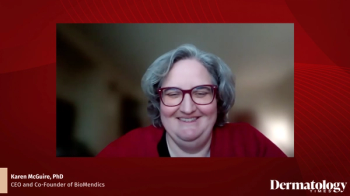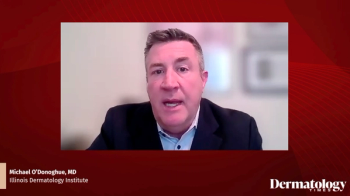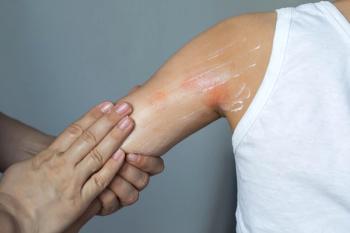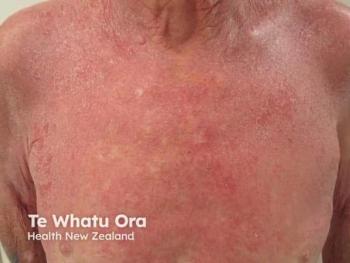
Understanding How Data Analytics Help Improve Health Outcomes With Stefan Weiss, MD
Weiss is the managing director of dermatology at OM1, a data analytics company with a health care focus.
“At the end of the day, what we want to do is bring the right drug to the right person at the right time. We all are in dermatology for the purpose of making the lives of our patients better. Historically, we've relied on case reports and case series in one-offs. But to take datasets of 75 to 150,000 individuals in a well-represented geographic, gender, ethnic, and racial cohort and see how treatment paradigms are similar, how they're different, and where we can tweak those treatment paradigms such that we can maximize the clinical benefit of patients is a tremendous asset, and having the opportunity to partner with the AAD to do that really brings a great advantage to the specialty and to our patients.” said Weiss.
Transcript
Weiss: Hi, I'm Stefan Weiss. I'm a board-certified dermatologist. And I lead the efforts in OM1 focused on dermatology.
Dermatology Times: Can you please provide an overview of OM1 and your role within the company?
Weiss: So OM1 is a large-scale data analytics company that focuses on improving health outcomes generally. So, the thesis within OM1 is to focus on all of the clinical specialties outside of oncology. So, dermatology, rheumatology, and gastroenterology within the immunology space, cardiac disease and kidney disease and cardio metabolic, and then mental health in neurology and the neuroscience group. I lead all of our efforts around the dermatology side of data collection, data analysis, research, and personalized medicine with a larger team within the OM1 structure. This gives us an opportunity to create research-ready datasets in psoriasis, atopic dermatitis, hidradenitis suppurativa, alopecia areata, and vitiligo as well as leverage OM1's phenome product, which is the artificial intelligence mechanism by which we're able to do patient finding and predictive analysis in how it portrays into dermatology.
Dermatology Times: How can OM1 and your team specifically assist dermatologists and dermatology providers?
Weiss: Alright, so in large part, it's really understanding what are best practices within dermatology. And that's not necessarily best practices in terms of who is doing what, but how we're getting better outcomes for patients because at the end of the day, that's why we're all in this. And so whether it's finding that a particular therapeutic may work better for a specific type of individual, gender, race, etc, whether certain disease presentations are going to be better responders to certain medications. So again, the scalp psoriasis performed better within a certain class of therapies versus palmoplantar psoriasis. And what are the better mechanisms by which we can improve patient satisfaction in diseases like alopecia areata and vitiligo? So, it's really how do we use data in a way to drive improved outcomes and understand who the patients are. Who would best respond to certain treatments? And we can think about this both before the treatment comes to play, or afterward. So, it's easy to discuss which psoriasis drug should we choose in the setting of scalp psoriasis in women versus palmoplantar psoriasis in men. But even more importantly, when we think of rarer dermatologic conditions like granuloma annulare, cutaneous lupus, and bullous pemphigoid, those disease states that have no therapy currently available, is there a mechanism by which we can identify patients who would be best served as clinical trial candidates for new therapies so that we can optimize the efficiency of clinical trial enrollment, which enables us to bring a therapeutic to market faster, that be both more efficacious and safer.
Dermatology Times: Can you please provide highlights from OM1's recent ISPOR 2023 poster, "Real World Characterization and Management of Alopecia Areata Patients in the US?"
Weiss: Right, so alopecia is a disease with a tremendous burden on patients. And so, when you really think about it, we sort of take most of our hair for granted. Now, as we age, both men and women lose hair due to hormonal changes, which does create certain aspects of being self-conscious with that. But now imagine one day you woke up and a plaque of hair was missing from the side of your scalp, or even worse, you are without eyelashes, or eyebrows. This is the burden that alopecia areata places on people. Historically, there has been nothing to use on these individuals other than topical steroids or injectable steroids, which are functional when the disease is on the scalp, face, or neck, but less functional when it's in the eyebrows and nonfunctional when it's the eyelashes. And so, understanding how dermatologists are treating these individuals in the real world gives us an opportunity to expand the way dermatologists can treat these patients as new therapies are being released. And so, dermatologists and their patients for whom they're treating with this disease have been fortunate to receive baricitinib as a newly approved therapeutic in alopecia areata and to understand the level of severity of patients within the dermatology community that have alopecia areata, and to understand how those individuals were being treated up until the introduction of baricitinib, gives us a real opportunity to begin to demonstrate new ways to derive high-quality treatment paradigms for these individuals, as new medications come to market
Dermatology Times: Can you please provide highlights from OM1's recent ISPOR 2023 poster, "Patient Characteristics and Social Determinants of Health in a Large Real-World Cohort of Vitiligo Patients in the US?"
Weiss: So again, vitiligo like alopecia areata is a disease state that has a tremendous effect on an individual's self-appearance and self-consciousness. And when you have individuals who are losing pigment, specifically in areas that are visible like the face, like the hands, you can imagine the burden that disease may place on them. It's even more critical and we think about this from a social determinants standpoint, because darker-skinned individuals suffer disproportionately from vitiligo, both in numbers and in impact. Clearly, if a very light-skinned individual loses pigment on the hands, it may not be as noticeable as if a darker-skinned individual. So, we characterize in dermatology as Fitzpatrick types V and VI skin. And so how we are able to manage that with patients is critical to improving their well-being in the way they can interact with others in terms of their own social functioning. The classic ways that this has been treated, as was outlined within the research is with topical steroids, topical calcineurin inhibitors, and light treatments, most of which become somewhat burdensome, either when there's too much body surface area involved in terms of the application of a topical, or the difficulty of using light treatment either in the office which requires 2 to 3 days, a week of visitation, or having a home light box. Again, much like alopecia areata, there's been the advent of new therapies around JAK inhibition that have shown tremendous promise, a topical JAK inhibitor has already been approved and there are numerous systemic JAK inhibitors that are under investigation for this disease. So again, understanding how dermatologists are treating patients with a disease like vitiligo in where are the opportunities to change those treatment patterns are to derive improved benefits for those individuals becomes key. And so, by leveraging large real world data cohort, all of which comes from practicing dermatologists as collected within DataDerm which the American Academy of Dermatology's database for these patients, gives us a real opportunity to understand where we were and where we're going. Because at the end of the day, what we want to do is bring the right drug to the right person at the right time.
Dermatology Times: What do you want physicians and other providers to know about OM1's resources?
Weiss: We specifically in dermatology are tremendously focused on leveraging the data that's been collected across this large cohort of individuals in AAD's DataDerm to improve health outcomes. And again, it really gets back to what I was saying before, which is to bring in the right drug to the right patient at the right time. And the only way to do that is to use large scale datasets in the ability of OM1 to construct a research-ready grade dataset from a clinical narrative and then when appropriate, leverage AI technology on top of it to create this ability to phenotype individuals so that you can demonstrate who will be best served by any particular product is a tremendous advantage not only for the specialty, and those of us, we're seeing patients within it. But those who are on the drug development side, as well as payers to really understand how do we again, get the right treatment to the right patient so that we are maximizing the efficiency of care. We all are in dermatology for the purpose of making the lives of our patient better. And historically we've relied on case reports and case series in one-offs. But to take datasets of 75 to 150,000 individuals in a well-represented geographic, gender, ethnic, and racial cohort and see how treatment paradigms are similar and how they're different, and where we can tweak those treatment paradigms such that we can maximize the clinical benefit of patients is a tremendous asset and having the opportunity to partner with the AAD to do that really brings a great advantage to the specialty and to our patients.
[Transcript edited for clarity]
Newsletter
Like what you’re reading? Subscribe to Dermatology Times for weekly updates on therapies, innovations, and real-world practice tips.


















